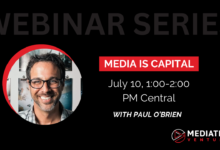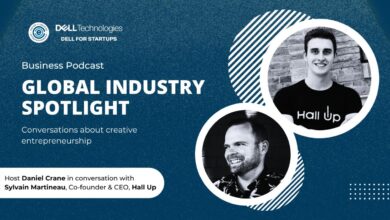Minimum Viable Media is a Better Start than the Minimum Viable Product

One of our favorite visuals in startup incubators, the popular Skateboard -> Car graphic is a wonderful way for founders to appreciate the concept of a Minimum Viable Product. The “MVP,” is such a frequently cited concept in entrepreneurship that you can’t escape hearing the term; it’s used so much so that in our encouragement that founders never pitch with buzzwords, we have to remind ourselves in the startup community that “MVP” is a buzzword of our own.
What is a Minimum Viable Product?
Don’t let my headline fool you into thinking I’m going to criticize the MVP; a Minimum Viable Product is a VERY important concept to understand and an invaluable lesson for founders. Unfortunately, far too many advisors, investors, and even articles or startup program, do a rather poor job of explaining what minimum viable product actually is. For startup founders, the premise behind an MVP is to stress to founders that you never (NEVER, I’m stressing) start out by building all that you want to have in a solution you’d like to bring to market.
Overwhelmingly most startups and development efforts fail, and building THE definitive product you want to bring to market is wasteful not just because that entire investment of your time and money is likely to fail, but because even if you find success, you can’t possibly know now, at the start, what that complete product should be. In your hubris and experience as a founder, you THINK you know the solution, and you WANT to create what you have in mind, but you must abandon that determination, and instead orient your vision to accomplishing the mission of capably serving the opportunity that you’ve set out to address. HOW that will work is not possibly something you can be certain of today. The Minimum Viable Product is the mindset to embrace; that you’re work starts by doing as little as possible, to validate and prove that it works, while learning what should be added or done next.

A version of a product with just enough features to be usable by early customers who can then provide feedback for future product development.
Being a founder, ponder this, are you REALLY going to just fund and build the car, outright?
A version, with just enough features to be usable by early customers who can then provide feedback for future product development.
That visual is valuable because most tend to misunderstand what we mean when we’re encouraging founders to build only an MVP.
A process typical of most, driven by PRODUCT development wherein the complete product intended is known, is that we build the parts and put them together. When we KNOW we want a car (as a Company such as Tesla knows the car is the conclusion intended) engineers can piece together a car given the new designs, sourced parts, and development of the new features that distinguish that car: attach wheels to the frame… This is product management and product development and it is precisely how and what companies do to bring a product to life.
Your work, as a founder, and with a startup, is not bringing a new product to life, it’s solving a new problem and creating new customers for a new solution. You don’t know that the car is what really solves their problem; you only think is it.
Let me clarify. If you’re certain I’m wrong and that the car is the right solution; the you’re not a startup, you’re not building a startup product, because you’re merely trying to create something we ALREADY know should exist, how it’s sold, and how the company for such a thing works. The idea of a Minimum Viable Product is critical to startup founders because a startup isn’t the start of creating a company doing what people already know how to do but rather addressing an unsolved problem with an innovative solution – we don’t yet know the “car” is the best way to solve what we’re trying to solve.
To conceive of the right start to an MVP, what matters most is being clear about your Mission and Values – what have you set out to accomplish? And in your values as a founder and company, what are the things you will or will not do?
With that clear, your venture might be – People can’t capably get around in a densely packed, urban environment, with insufficient roads and too little parking.
How do we prove that’s true, that people will pay for a solution, and that we can capably deliver a solution that is competitive and valuable in the market? We start with a minimally VIABLE product – the skateboard.
Of course, the skateboard on one end of that visual and the car on the other end, misleads us a bit in trying to get this concept across to founders; because it APPEARS that we do have the car in mind and that we might best start with something that already exists, the skateboard. That’s NOT how we should think about an MVP.
The MVP of our venture appreciates that what we might test and prove that we can do is provide something incredibly affordable and smaller to substantiate that *we* are capable of doing that, that people will buy it, and that indeed, something smaller, moves us along the path of our mission – a better means of transportation in that limited space.
With that skateboard in the market, we then LEARN that, we probably want to attach the handlebars to it. Our initial audience has proven the wheel on a board helps, but people need more control, they’re willing to pay for that, and that our first iteration is too hard for most to use, so if we make it easier, our market expands. Knowing that, from our market, we make the informed investment in adding the stick, and bring a new version to market; further proving, validating, and growing our audience, increasingly accomplishing our mission, now as a bigger venture.
That’s the process of developing an MVP. And unfortunately, what’s missing or misled in most of the education about the MVP and this process, is that it isn’t Product Development, it’s Marketing.
Because the Purpose of your Venture is to Create a Customer, Marketing and Innovation, are your Priorities and what Create Value – and Marketing is the Distinguishing of the Two
The Minimum Viable Product is the process of building as little as possible, sufficiently viable that it in and of itself though, is valued and viable, so that you can learn from the market what best to do next. That process, in a nutshell, is what we call Marketing.

Keep in mind…
Marketing is NOT advertising or promotions. Marketing is not what you do when you’re ready to sell or go to market; advertising, promotions, and sales are things marketing does when appropriate to accomplishing that.
Marketing is the work of the Market. Knowing the industry, studying competitors, learning from audiences, and talking to customers, partners, and investors, to INFORM the business about what to do.
Hence, Minimum Viable Media
Let’s translate over a couple of words from Peter Drucker’s notable observation. Innovation is a word associated with the product brought to market while marketing and media are rather joined at the hip, intertwined since media is a tool of marketing – to reach audiences, to communicate, to show, to entice, and to excite.
And of course, thanks to data, web analytics, and business intelligence, we can learn a lot from our audiences through media. This is called marketing.
In entrepreneurship, we often see a chicken or egg kind of scenario which really shouldn’t exist. That scenario is which comes first? Do we need the product first in order to bring it to market and test and sell what we’re hoping to accomplish or do we do marketing first to determine what products to bring to market?
Unfortunately, far too many Product Managers and Executive, champion an argument that the product comes first. You’ll hear a great many advisors and investors encourage you to get a product to market so that you have customers to ask. Engineers, understandably, are oriented to building something; obviously we need something to work with in the work we do as developers.
But as “innovation,” how on earth do you know what it’s first worth building?? How do you know what the first step in that Minimum Viable Product should be?? We must first ask the market.
Our first step isn’t a skateboard, it’s some media, marketing, so that we know the skateboard is what to try first.
One of my great friends and a wonderful startup mentor, Brian Massey, has observed this and champions of the idea of a Maximum Viable Non-Product, “The idea is that you identify the absolute maximum feature set without actually building anything, then you launch it.” Marketing is the work of identifying that feature set, substantiating that it is what’s needed, and desired, and validating that people will pay for it.
Something comes before the skateboard. Some way to reach, inform, and learn from an audience. Media.
In MediaTech Ventures, we validate and draw from the tremendous amount of experiences with the Arts and Media industries which inform of us how to think differently as startup founders. For example, a relevant example in this context of a Minimum Viable Product: Does a Band simply start recording and producing an album? Their Product? Or do they first play, a lot, and perform for audiences songs that are rough, some horrid, and practice while building a fan base for which to produce some things?
Minimum Viable Media
Filmmakers never just produce a film. Investors in film (often “Executive Producers”) would never get on a board a project with some fresh filmmaker and a story.
What founders can draw from such experiences in the creative space is that Innovation (the distinctly new product), being a creative solution, works in much the same way – investors never support a startup just because some founders have an idea.
To bring that album, that film, or that venture to life, we have to first build something, the MVP, and before we build the something, we learn from the market what it might be worth building.
Filmmakers produce storyboards or a short film on their own, that band produces some music, and founders create a website, landing pages, some articles, or a pitch deck at least, *something* with which they start talking to people and getting feedback. Before developing a minimum viable product, create the minimum viable media – the media that in and of itself, viably conveys the intent and opportunity, so that you can learn from the audience might support, and validate that it’s worth further investment.
How do people raise money on Kickstarter?? Certainly NOT with the Product ready to go; they start with a video, photos, descriptions, and some excitement, for what they hope to bring to market.
How best to start? How to learn what MVP to build?
- Newsletter sharing perspective about the industry
- Landing page with a value proposition and form
- Social Media Group for your audience
- Video that excites people about what you have in mind
From such media, you’ve already proven some interest and demand for what you want to do. You’ve proven that you can get that demand. And you have feedback and an audience with which to ask more, so that your investment in building a minimum viable product, is worthwhile. Media, to do marketing, to know what Minimum Viable Product gets you on the right track.
Creating minimum viable media isn’t difficult and it’s something everyone can do. How do you start a startup? You create that media. If we can help, even just to show you how, let us know.
Learn more about the MVP
Tune in to Satish Kamsali as he joins Kristie Whites in our Code is Not Prerequisite series: Build your MVP the Right Way







Love this. We are taking action immediately! We are exploring setting up a slack community since we are helping business people boost their energy and level up productivity. Are there any other recommendations on community platforms to explore
Ooo let’s chat that, because I’m not as 100% sold on Slack as I once was. Discord drawing a ton of preferences in people plus, I’ve never been happy with how we can build groups and communities, but then they end up being disparate from one platform to another (Slack doesn’t integrate well with much).
Desperately seeking (would love referrals as well everyone) any platform that ties everyone together. That is, let people use whatever they prefer, for comms, social media, messaging, etc. while putting in place an “app” wherein everyone in the community can see, connect, chat with *everyone* else.
I am with Dr. David Heitmann DC, MS: I love this. A waterfall approach doesn’t allow to consider the targets’ anticipated feedback on an MVP. Parallel phases should be set up and carried out.
Nice! A great step back from the myopic preoccupation of busting the door down… to an appreciation for ringing the bell. Plus, why roll out your best iteration ahead of market demand, so more established companies with brand reputation, backing and infrastructure can make off with your innovation? If an idea really is that much of a magnificent departure from norm, you’ll need a margin of cash and time just to educate your market before they’re likely to buy…
This would be good content for Jon Gosier as he’s the expert in all things film/VC.
Paul O’Brien Patrick Dewey happy to be a resource. The above is great advice. As someone who’s been both a VC and an Executive Producer/Investor for many films, you hit the nail on the head.
Jon Gosier any chance I can pick your brain about how to best sell a documentary that’s already complete?
Eric Daniel Horn Always happy to chat with anyone but sales and docs are not really my area of expertise. Probably better to target production companies that have sold docs or sales agents who specialize
Mr. Jon Gosier, Patrick Dewey says you’re the “expert in all things film/VC.” I’m working on a couple of tv/film projects and would love the opportunity to speak with you. I just sent you a message via LinkedIn.
Chris Moreno Daley Ervin certainly worth a closer look at Media innovation in Atlanta, if we have a community there including people like Jon Gosier
Great connect Patrick Dewey, cheers
Great share, Paul! Sent along to a few friends…
Cheers Eric Daniel Horn. Hope you’re well! Happy new year
That’s how we launched SocialGrow Inc. We had 35,000 followers on Twitter when we launched and I think 10K hits on our website when we did launch. Thanks CMO Ken Herron!!
Awesome Marsh Sutherland and thank you! Wonderful affirmation of the thesis here
Timely topic! Great stuff Paul. You have validated my thoughts exactly to working too hard towards a fully baked product only to realize the market wants something slightly different = time wasted, expectations missed.
Cheers Clayton Simmons great share because that’s precisely the point. How might we reduce the rate of complete failure? We source more data and support about what to avoid trying and what to invest in building.
Great write up Paul. I’ve been discussing this with some media connections over the past few months, but didn’t think to term it like you have. Really helps simplify the concept! Would love to discuss some of what’s in the works with you as it has a direct relevance to Austin and where your focus seems to be around Media.
Cheers Mathew Yarger, I have a slammed week through Thursday but would love to catch up. Let’s find a time immediately thereafter!
Lot of cross over between developing & producing tv & movies and startup building. Great comparison and advice
Yes! I love these perspectives!!! Wrote this too, you might enjoy [How Star Wars Defined a Generation of Entrepreneurs](https://mediatech.ventures/star-wars-defined-generation-entrepreneurs/)
Amazing, insightful post. It made me pause and review what I’m working on and why. Thank you for writing this up!
There is no more wonderful feedback than that what someone has said, has made a difference in their life. Thank you!!
tee hee hee – its about getting the angle of your ambition and scope right. I liken t to a Howitzer. Everything takes forever.
So to get your timing right, learn how to rea Tea leaves and predict the future.
Make sure:
a) that the product is great enough – and will have legs
b) then “eat your own dogfood” (use your product to tell your story)
c) then find Celebs to use it and invest in it
d) and, of course HiProfile Brands to become your customers
That’s the Instigate.ai playbook.
Its helps to have fans and Alumni that you’ve helped in their careeers.
https://www.youtube.com/watch?v=rx-RK3j4rW4